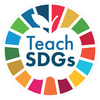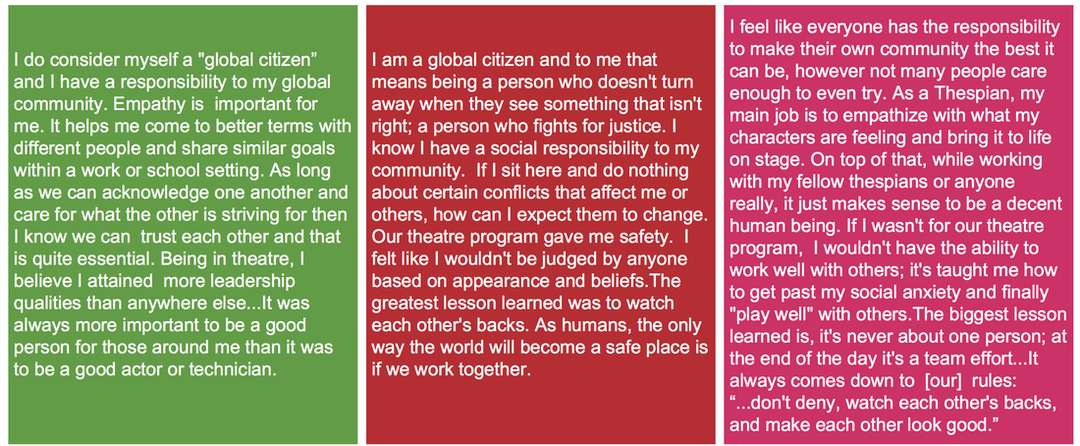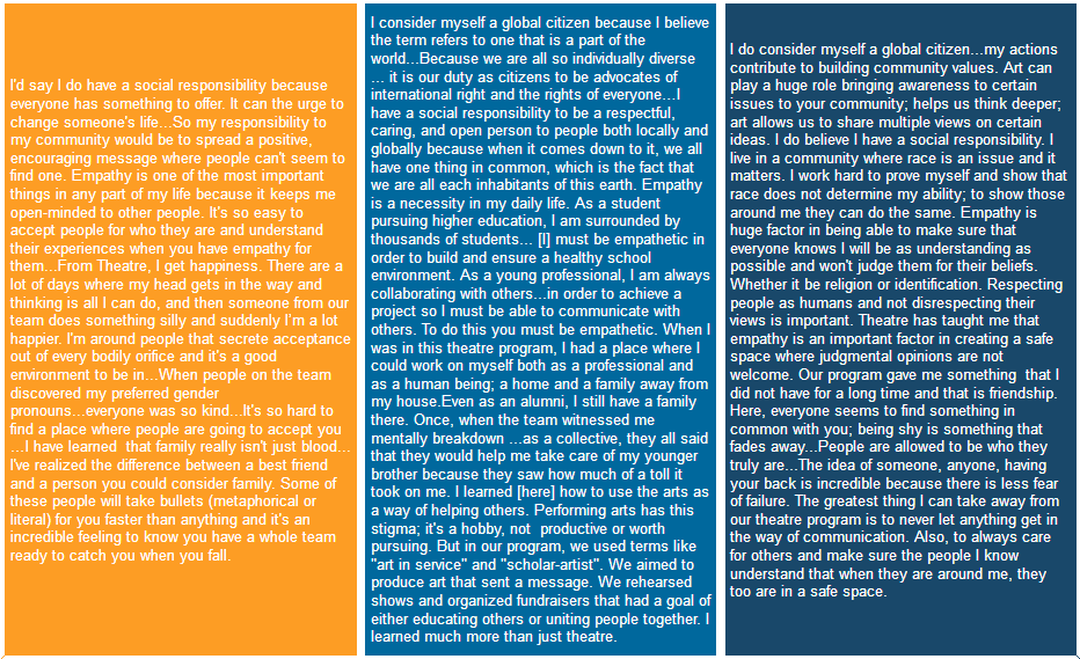|
By Estella Owoimaha-Church, Global Teacher Prize Finalist (2017), #TeachSDGs & Varkey Teacher Ambassador, Theatre Teacher, California Presently, I lead a theatre department in Los Angeles. In 15 years of service, I have found the most compelling tool, strategy, and resource is ‘empathy’. I have been in my current position for four years now and, over the previous year, I have grown particularly mindful of this fact. It’s simple. Empathy is a more complex cognitive function than we give it credit. You may not find it listed on a Bloom’s Taxonomy chart or Webb’s Depth of Knowledge infographic, though studies as far back as the 1870, perhaps earlier, have already proven empathy development to be critical. We consider it important, but only as it relates to character development or morality. How often do we consider curricular implications of empathy? Empathy has two functions: the affective and the cognitive. Affective empathy allows us to be in tune with another's feelings. This might manifest as mirrored emotion--feeling sad when a close friend is feeling down. Cognitive empathy involves a person’s ability to fully understand and identify what someone else is feeling and perhaps assume a similar perspective. While being an empathetic person does not guarantee you’ll take action when a person is in need, it is a positive indicator of action in the future. (Baron-Cohen & Wheelwright, 2004; Decety & Ickes, 2011; UC Berkeley, 2017) As educators, we need to, very thoughtfully and carefully, craft ways to embed empathy in curriculum, activities, culture, environments, and daily practice. Educational policy seems forever in flux and education reform never seems to be as transformative as intended. Empathy will withstand the proverbial education pendulum and is a prerequisite for this field. Empathy is free and accessible to all, no wireless internet necessary. Empathy is not a vague, idealistic concept, nor will it be mastered in one lesson or unit. Empathy is content, to be taught explicitly as we would teach foundational literacy skills. Empathy creates a basis for positive and engaging environments. Empathy shapes the minds and hearts of youth, building up global citizens who are change agents and that can therefore be vehicles to reach the Sustainable Development Goals by 2030. 9 Compelling Reasons to Explicitly Teach Empathy I have found that by engaging students in empathy based content, modeling empathy daily, and encouraging students to practice empathy, I can cultivate a safe space where academic and artistic risks are taken. In such a space, students are inclined to take care of one another, as well as assume responsibility in establishing a safe, inclusive environment. UC Berkeley, in Greater Good Magazine (2017), outline several extensive studies on empathy in a concise, comprehensive discussion on what empathy is, why we should be concerned, and approaches to employing empathy as a tool. Below are findings from this resource followed by anecdotal data to support what the research says. Developing empathy in individuals can:
Religion, Gender Identity, & Acceptance In our theatre program, we have students representative of various religions; Catholic, Jehovah's Witnesses, Muslim, Wiccan, Agnostic, and others. Tolerance and coexistence is not always easy. Over the last two years, I have witnessed courage and bravery flourish in students who chose to stand in their truth and honor their identities; the choice to self-select a religion; the choice to come out as an LGBTQ+ person. At times, difficult and painful conversations happen. Such was the case this school year when a student - who identifies as a male - asked another student - who self-selected a religion that disagrees with varied gender identities - to please use his preferred pronouns and male name. Her initial response was “I don’t know if I can do that because it’s sort of against my religion.” After a long conversation, with all theatre company members, her response shifted to “I love you, no matter how you identify, and I can respect your wishes because I love you.” To which the response was, “I love you as well. And, I am proud of your religious conviction and will honor your choices.” These courageous conversations continue to happen. What I am most proud of is the growth each student exhibits when they learn something new about a person and can conjure empathetic solutions. When empathy is developed on the individual level and as a group norm, what begins to emerge is a community and ensemble where tolerance and coexistence is merely a way of being; it's natural as opposed to contrived. It becomes the group’s goal, motivating them push past initial differences or potential conflicts. Support Systems & Forgiveness A founding member of our theatre program graduated two years ago. Her younger brother remains in the program. This alum was known across campus as a superstar; the hardest work kid you wished was in your class whose potential was only matched by her own tenacity; a real leader in our program and member of several other academically rigorous programs. This student held major responsibilities at home--daily chores, cooking, cleaning, and raising her younger brother. This was a great strain on her, yet somehow she persisted. During senior year, her teammates noticed she was near a mental breakdown. They called a meeting to talk to her. I anticipated it was to discuss her younger brother who had been caught stealing on several occasions and the latest incident involved the box office till. I sat and listened, trusting in their ability to have a conversation, rooted in empathy. Her teammates said this, and I am paraphrasing: “We see that you are under a lot of pressure and stress right now. We want you to try to enjoy senior year and focus on all the things you have to worry about right now. Let us carry the load while at school. We’ll look out for your younger brother. We are a family so he is our responsibility, too. Having your back means we have his. He was caught trying to take that cash, but we understand. He was probably worried about your dad. We can take turns spotting lunch if you need us to.” Cue tears and group hug. I sat at my desk in awe, trying not to cry. To this day, while she is away at university, remaining team members continue to keep the promise made by previous students. The anecdotal data I could share is abundant; stories of students who have mastered empathy and chose to practice it daily, and in ways I wouldn't have imagined. I’ve had theatre students volunteer to lead teacher professional development on “Empathy and Community Building” after being inspired to act when peers were made to feel inadequate based on gender identity and immigration status. A theatre student who is autistic was told he would never be able to go to college by a counselor; well he in fact did and then made it his mission to mentor other students with similar conditions helping them fulfill personal goals. After theatre students were unjustly targeted by district officials, they stood together, advocating for the department and each other. And when mental health concerns rose for several teammates, they sought out professional help and supported one another through weekly therapy sessions. Each time my theatre students are faced with a conflict or challenge, they choose empathy as the basis for their solutions. I am always impressed and grateful for the opportunity to bear witness. 5 Strategies for Teaching Empathy & the SDG’s There is an infinite number of ways to teach and support the Sustainable Development Goals, I’m sure. Just the same, there are a number of ways to embed empathy in your practice, whether you are a classroom teacher, paraprofessional, or community member. The research shows that we can develop empathy using specific activities, such as providing opportunities for active listening, shared identities, personal stories, meditation, game or role play, exploration, and imagination. A more comprehensive list can be found at Greater Good Magazine. Below are some strategies we use in our theater program. 1. Safe Space: Ensure the communal environment is culturally responsive to all those who will have a hand in shaping the space. The environment should be safe where learners and facilitators are free to take risks and fail without judgment, but with support of peers. Group norms are always visible and all have a voice in defining the norms. Consider roles of group members and mitigate ego trips by maintaining equality in the space. One simple way to do this is to have team members sit in a circle whenever possible, including the facilitator. Speak honestly and in the affirmative as often as possible. 2. Service Learning: Prioritize kindness and generosity. Highlight stories of youth who have created good-will campaigns or have contributed to the greater good (e.g. Malala Yousafzai, Dude Be Nice, or KidPresident). Most importantly, encourage students to do the same. A project we do annually in the theatre program is called “Art in Service." Students are required to review the SDG’s and the Universal Declaration of Human Rights. In small, self-selected groups, they decide what issues are most pressing given their personal identities and worldviews. Students work together to create a campaign employing their art in significant ways. The project involves extensive checkpoints, research, and feedback loops. By the end of the year, students share their findings or results of their direct actions. 3. Use Curriculum that Already Exists: There are plenty of curriculum packages out there that can easily support your content area, the SDG’s, and empathy development. Speak Truth to Power shares the narratives of human rights defenders all over the world and includes cross-curricular texts and projects. Rock Your World is a “dynamic project-based curriculum that engages middle and high school students in the use of creative media to take informed action about issues they care about.” Teaching Tolerance and Facing History & Ourselves are always in abundance of amazing resources. 4. Text Selection: Explore bodies of work across content areas that encourage students to empathize with individuals that are not like them. Encourage students to make connections with others where they once imagined there weren’t any connections. Islamophobia, unfortunately, is trending in the United States. Since incorporating texts by and about Malala Yousafzai, I have seen a change in student conversations. Malala is considered a hero, a rockstar among students--some idolize her. Knowing her story gives youth perspective and encourages them to be brave. Some great texts (should not be limited to novels or books) to start with are I Am Malala, The Laramie Project, Americanah, and In the Country We Love. 5. Personal Narratives: Encourage students to tell stories and share them with one another. Document these narratives; use essay writing, voice recorders, or other creative formats. Play these stories back, allowing students to fill the role of someone else. When students feel the pressure to get someone else's story right, they listen more intently and work hard to honor their peers’ humanity and voice. Some specific tools and strategies include verbatim theatre, playback theatre, or StoryCorp. This is a fantastic way to incorporate community members and our elders, as well connect to distant communities around the globe (via technology)(Bornmann & Crosman, 2011; Holland, 2009). The above strategies directly support the following Sustainable Development Goals: Need additional ideas? Read “Arts Education and the SDGs” When Empathy Translates into Global Citizenship & Enhanced Partnerships for ‘The Goals’ In “Soft versus critical global citizenship education,” Vanessa de Andreotti (2014) presents a model for supporting learners on their journey of global citizenship. She makes many great points and highlights, in very plain language, the difference between soft and critical global citizenship. Similar to the difference between affective and cognitive empathy--the difference being action--soft and critical global citizenship are closely linked; the primary being a step towards the ladder. Andreotti warns that if we are not willing to confront our own assumptions and limitations then we risk “reproducing the systems of belief and practices that harm those” we wish to serve. Theatre students from the past four years, including alumni, were polled on their views pertaining to their responsibility as global citizens and the role empathy plays in their lives. Students’ responses were edited for security, brevity, and clarity. Here is what some had to say: #TeachSDGs with Empathy: Share these quotes in your learning spaces Download these images and more in poster format by clicking the above link. Works Cited Anderson, M. (2007). A resurgence of verbatim theatre: Authenticity, empathy and transformation. Australasian Drama Studies, 153-169. Baron-Cohen, S., & Wheelwright, S. (2004). The empathy quotient: an investigation of adults with Asperger syndrome or high functioning autism, and normal sex differences. Journal of autism and developmental disorders, 34(2), 163-175. Blair, R. (2009). Cognitive neuroscience and acting: Imagination, conceptual blending, and empathy. TDR/The Drama Review, 53(4), 93-103. Bornmann, B. A., & Crossman, A. M. (2011). Playback theatre: Effects on students’ views of aggression and empathy within a forensic context. The Arts in Psychotherapy, 38(3), 164-168. de Andreotti, V. O. (2014). Soft versus critical global citizenship education. Development Education in Policy and Practice, 21-31. Decety, J., & Ickes, W. (2011). The social neuroscience of empathy. Dennis, R. (2008). Refugee performance: Aesthetic representation and accountability in playback theatre. Research in Drama Education, 13(2), 211-215. Freeman, B. (2012). The social neuroscience of empathy in the theatre of global ethics. Performing Ethos: International Journal of Ethics in Theatre & Performance, 2(1), 41-54. Holland, C. (2009). Reading and acting in the world: conversations about empathy. RiDE: The Journal of Applied Theatre and Performance, 14(4), 529-544. UC Berkeley. "Empathy Defined." Greater Good Magazine. UC Berkeley, 2017. Web. 26 July 2017. <https://greatergood.berkeley.edu/empathy/definition#why-practice>.  Estella Owoimaha-Church was recently named a Global Teacher Prize Finalist (2017). She holds an M.A. in Education: Language Arts & Literacy from Loyola Marymount University and a B.A. in African-American Studies: Urban Education from California State University, Northridge. Estella teaches theatre in Los Angeles, helping youth to employ performing arts as a community service tool. Mrs. Church is an education consultant, as well as a reading, curriculum and pathway specialist. Though in the classroom full time, she remains active with several community organizations, including Robert F. Kennedy Human Rights, training teachers in human rights and social justice education. “The arts are a transformative tool; when paired with the SDG’s, the arts can heal communities and build bridges, cultivate youth into global citizens, and usher in the SDG’s by 2030.” She is humbled and looks forward to serving her community as an #TeachSDGs & Varkey Teacher Ambassador. Connect with Estella on Twitter at @eochurch. 5/24/2019 09:18:28 pm
Thanks for the information your blog brings. I see the novelty of your writing, I will share it for everyone to read together. I look forward to reading many blogs from you. Comments are closed.
|
AuthorSTeachSDGs Team & Contributors Archives
November 2019
Categories |









 RSS Feed
RSS Feed